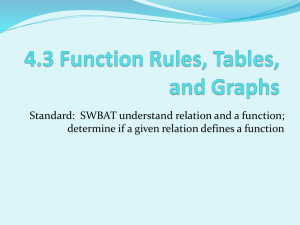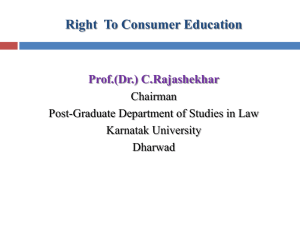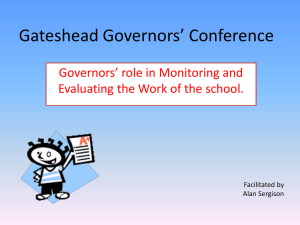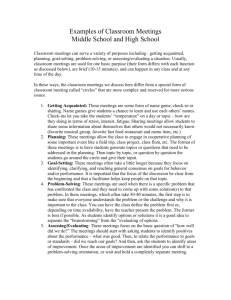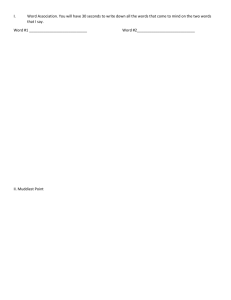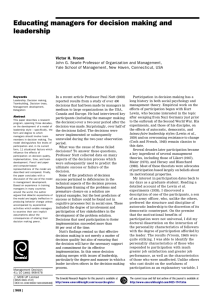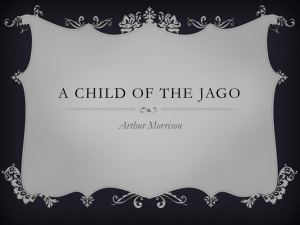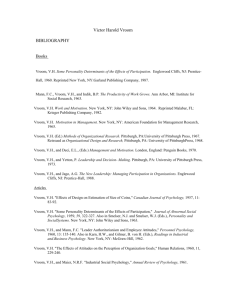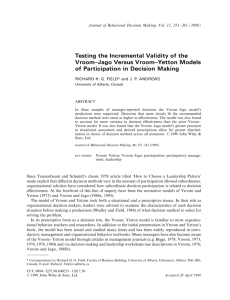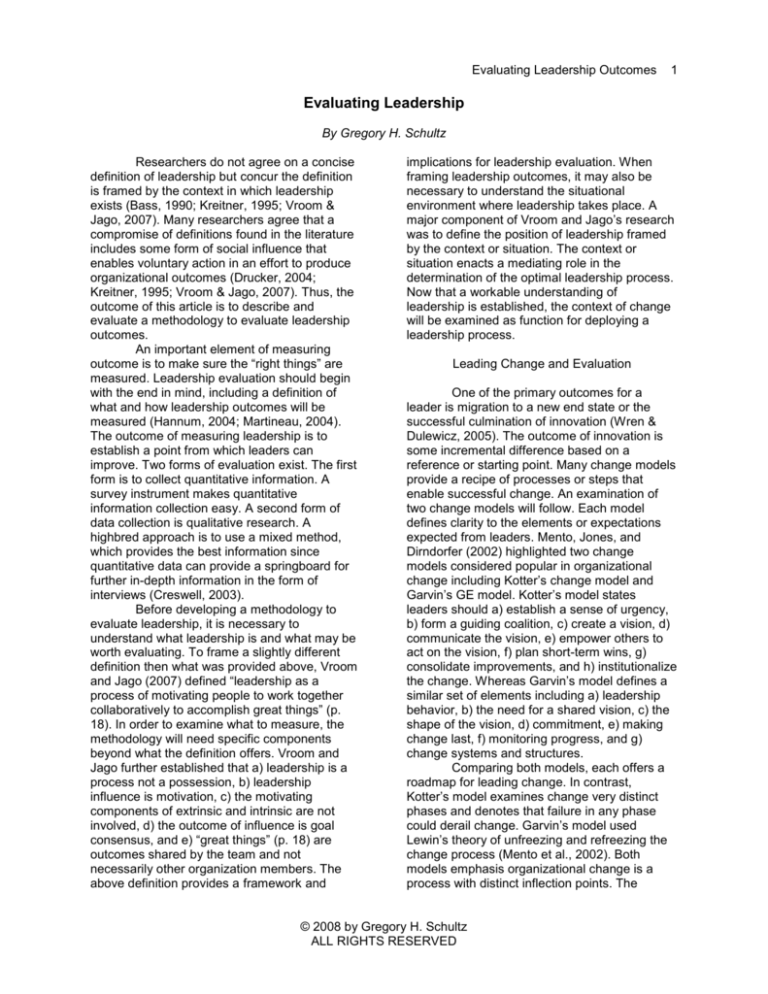
Evaluating Leadership Outcomes
1
Evaluating Leadership
By Gregory H. Schultz
Researchers do not agree on a concise
definition of leadership but concur the definition
is framed by the context in which leadership
exists (Bass, 1990; Kreitner, 1995; Vroom &
Jago, 2007). Many researchers agree that a
compromise of definitions found in the literature
includes some form of social influence that
enables voluntary action in an effort to produce
organizational outcomes (Drucker, 2004;
Kreitner, 1995; Vroom & Jago, 2007). Thus, the
outcome of this article is to describe and
evaluate a methodology to evaluate leadership
outcomes.
An important element of measuring
outcome is to make sure the “right things” are
measured. Leadership evaluation should begin
with the end in mind, including a definition of
what and how leadership outcomes will be
measured (Hannum, 2004; Martineau, 2004).
The outcome of measuring leadership is to
establish a point from which leaders can
improve. Two forms of evaluation exist. The first
form is to collect quantitative information. A
survey instrument makes quantitative
information collection easy. A second form of
data collection is qualitative research. A
highbred approach is to use a mixed method,
which provides the best information since
quantitative data can provide a springboard for
further in-depth information in the form of
interviews (Creswell, 2003).
Before developing a methodology to
evaluate leadership, it is necessary to
understand what leadership is and what may be
worth evaluating. To frame a slightly different
definition then what was provided above, Vroom
and Jago (2007) defined “leadership as a
process of motivating people to work together
collaboratively to accomplish great things” (p.
18). In order to examine what to measure, the
methodology will need specific components
beyond what the definition offers. Vroom and
Jago further established that a) leadership is a
process not a possession, b) leadership
influence is motivation, c) the motivating
components of extrinsic and intrinsic are not
involved, d) the outcome of influence is goal
consensus, and e) “great things” (p. 18) are
outcomes shared by the team and not
necessarily other organization members. The
above definition provides a framework and
implications for leadership evaluation. When
framing leadership outcomes, it may also be
necessary to understand the situational
environment where leadership takes place. A
major component of Vroom and Jago’s research
was to define the position of leadership framed
by the context or situation. The context or
situation enacts a mediating role in the
determination of the optimal leadership process.
Now that a workable understanding of
leadership is established, the context of change
will be examined as function for deploying a
leadership process.
Leading Change and Evaluation
One of the primary outcomes for a
leader is migration to a new end state or the
successful culmination of innovation (Wren &
Dulewicz, 2005). The outcome of innovation is
some incremental difference based on a
reference or starting point. Many change models
provide a recipe of processes or steps that
enable successful change. An examination of
two change models will follow. Each model
defines clarity to the elements or expectations
expected from leaders. Mento, Jones, and
Dirndorfer (2002) highlighted two change
models considered popular in organizational
change including Kotter’s change model and
Garvin’s GE model. Kotter’s model states
leaders should a) establish a sense of urgency,
b) form a guiding coalition, c) create a vision, d)
communicate the vision, e) empower others to
act on the vision, f) plan short-term wins, g)
consolidate improvements, and h) institutionalize
the change. Whereas Garvin’s model defines a
similar set of elements including a) leadership
behavior, b) the need for a shared vision, c) the
shape of the vision, d) commitment, e) making
change last, f) monitoring progress, and g)
change systems and structures.
Comparing both models, each offers a
roadmap for leading change. In contrast,
Kotter’s model examines change very distinct
phases and denotes that failure in any phase
could derail change. Garvin’s model used
Lewin’s theory of unfreezing and refreezing the
change process (Mento et al., 2002). Both
models emphasis organizational change is a
process with distinct inflection points. The
© 2008 by Gregory H. Schultz
ALL RIGHTS RESERVED
Evaluating Leadership Outcomes
leadership process outlined by Vroom and Jago
(2007) shares distinct characteristics with the
change models highlighted. These
characteristics provide insight for the context or
specific situations that might be used to evaluate
leadership effectiveness.
Measuring Leadership Outcome
Using feedback to evaluate leadership outcomes
Since change is a major function of
leadership and successful change should equal
successful outcome, this section will examine
360-degree feedback as a method of evaluating
leadership outcomes. 360-degree feedback, in
essence, provides a snapshot or depiction of
behavior for some continuum (Alimo-Mecalfe &
Alban-Metcalfe, 2005). The outcome of
successful change is a supporting culture that
has embraced the institutional components of
change. Alimo-Mecalfe and Alban-Metcalfe
pointed out that organizational transformation
enables and drives the norms of the resulting
culture and culminates with a shared vision held
by the culture. Thus, perceptions of followers
should provide feedback about the behaviors
possessed and exhibited by leaders during the
transformational process. 360-degree feedback
provides precise information about leadership
strengths and weaknesses by a cross-section of
organizational representatives (Conger &
Toegel, 2002). Leaders must realize that
feedback is individual perception of respondents
and any advantage is based on how leaders use
the information.
To understand what elements
contributed to successful change and what
dimensions of leadership enabled successful
change, Wren and Dulewicz (2005) explored the
use of 360-degree feedback within the Royal Air
Force. Wren and Dulewicz identified a set of
leadership dimensions and a set of leader
activities found to be most beneficial for
successful change. The high dimensions
include: a) managing resources, b) engaging
communication, and c) empowering teams.
Whereas the most important leadership activities
included: a) a vision of the future state, b)
nurturing the culture, c) establishing early wins,
d) taking responsibility, e) not losing sight of the
big picture, and f) motivating the team. Wren
and Dulewicz were careful to point out that
successful change contains the most important
leadership dimensions and 360-degree
2
feedback offers rater input on the strengths and
weaknesses of each dimension.
Drucker (2004) stated the modern view
of leaders may be single dimensional given the
research in areas of charismatic leaders but
warned that great leaders are not from the same
mold. Thus, evaluating leadership outcome may
require some level of qualitative feedback. As
pointed out earlier, 360-degree feedback is a
good form of qualitative feedback. Martineau
(2004) stated the first critical step in any
evaluation process is to identify key
stakeholders. The right stakeholders for
leadership evaluation are people who have a
stake in the appropriate outcome. The right
stakeholders understand the context or situation
of the applied leadership process. Therefore,
stakeholders are the most relevant players in
defining outcome of the leadership application.
Organizational innovation as an outcome
Drucker (2004) stated leaders must ask
tough questions such as what needs to be done
in the organization. Doing the right things for the
organization does not take into account what the
leader would like to do; rather it focuses on what
makes the organization successful. For
organizations on the technology frontier,
innovation may be a way to measure leadership
success. Profitable innovations may be an
indication that leadership focus is on the future
and that leaders understand the external forces
acting upon their organization.
Researchers agree that measuring
revenue streams offers a tangible method of
evaluating innovation (Lanjouw & Schankerman,
2004; Shapiro, 2006). Shapiro posited,
"[p]ercent of revenue from new products is the
most commonly used measure of innovation" (p.
43). Examining the amount of patents filed
based on the level of research and development
provides a second method to measure
innovation. Patent submission is indicative of the
level or quantity of organizational innovation. In
their research, Lanjouw and Schankerman found
that patent release timing and product demand
had a strong correlation to organizational stock
price variation. The outcome of stock price
variation over time may mean that for some
firms, stock valuation could be a way to measure
periods of innovation. Therefore, organizational
growth and decline may be indicative of the
quality of leadership continuum. Historical
organizational growth and decline based on
stock valuation are tangible quantitative
© 2008 by Gregory H. Schultz
ALL RIGHTS RESERVED
Evaluating Leadership Outcomes
measures that are easy to located and
manipulate using mathematics.
Evaluating Leadership
Taking qualitative measures like 360degree feedback together with pre-defined
quantitative measures such as profit or stock
valuation offers a well-rounded view of
leadership outcome. Comprehending
perceptions of peers and followers aids in
understanding leadership behavior within the
organization. A multi-rater instrument or 360degree feedback develops a perspective of
leadership behavior from an external
perspective (Conger & Toegel, 2002). In order to
improve, leaders must know how to change
behavior and multi-rater feedback transfers
perceptions about self-knowledge (Conger &
Toegel). However, leader’s willingness to accept
feedback and apply the feedback to appropriate
areas of professional development defines
feedback effectiveness.
Vectors to rate during feedback
sessions include leadership strengths and
weaknesses based on the outcome of the
leadership process. 360-degree feedback
provides precise information about leadership
strengths and weaknesses in a cross-section of
organizational areas (Conger & Toegel). Each
area of feedback should be laden with actual
events that occurred, which will help define the
context.
A problem with 360-degree feedback
includes leadership acceptance of the feedback.
Facteau and Facteau (1998) found that less
3
than perfect scores affected leadership
acceptance of feedback by bringing into
question the leader’s perception of self. The
outcome of leadership evaluation is
developmental in nature. Developmental areas
highlight areas for improvement where leaders
are deficient. Conger and Toegel (2002) found
that leadership improvement resides in the
region between leader self-perception and the
perception of raters. Evaluating leadership
should provide a core understanding of the
qualitative components of leadership processes
including the application of influence coupled
with the quantitative measure of tangible
outcome such as innovation and stock valuation.
Conclusion
Researchers agree that the definition of
leadership is not concise but many frame the
definition within the context in which leadership
exists (Bass, 1990; Kreitner, 1995; Vroom &
Jago, 2007). Using stakeholders that understand
the context aids in leadership evaluation. 360degree feedback provides a qualitative method
to gather information about the leadership
process. Another technique uses quantitative
methods to collect information about
organizational growth and decline by examining
stock variation over time. Qualitative and
quantitative measures together offer a broad
perspective to evaluated leadership. The
evaluation provides correlation to tangible and
intangible components described by Vroom and
Jago’s (2007) perspective on leadership as a
process.
© 2008 by Gregory H. Schultz
ALL RIGHTS RESERVED
Evaluating Leadership Outcomes
4
References
Alimo-Metcalfe, B., & Alban-Metcalfe, J. (2005). The crucial role of leadership in meeting the challenge of
change. Vision-The Journal of Business Perspective, 9(2), 27-39.
Bass, B. M. (1990). Bass & Strogdill’s handbook of leadership: Theory, research & managerial
applications. (3rd ed.). New York: The Free Press.
Conger, J., & Toegel, G. (2002). Action learning and multi-rater feedback as leadership development
interventions: Popular but poorly deployed. Journal of Change Management, 3(4), 332-348.
Creswell, J. W. (2003). Educational research: Planning, conducting, and evaluating quantitative and
qualitative research (2nd ed.). Upper Saddle River, NJ: Prentice Hall.
Drucker, P. F. (2004). What makes an effective executive. Harvard Business Review, 82(6), 58-63.
Facteau, C. L., & Facteau, J. D. (1998). Reactions of leaders to 360-degree feedback from subordinates
and peers. Leadership Quarterly, 9(4), 427-448.
Hannum, K. (2004). Best practices: Choosing the right methods for evaluation. Leadership in Action,
23(6), 15-20.
Kreitner, R. (1995). Management (6th ed.). Boston: Houghton Mifflin.
Lanjouw, J. O., & Schankerman, M. (2004). Patent quality and research productivity: Measuring
innovation with multiple indicators. The Economic Journal, 114(495), 441-465.
Martineau, J. (2004). Laying the groundwork: First steps in evaluating leadership development.
Leadership in Action, 23(6), 3-8.
Mento, A. J., Jones, R. M., & Dirndorfer, W. (2002). A change management process: Grounded in both
theory and practice. Journal of Change Management, 3(1), 45-59.
Shapiro, A. R. (2006). Measuring innovation: Beyond revenue from new products. Research Technology
Management, 49(6), 49(6), 42-51.
Vroom, V. H., & Jago, A. G. (2007). The role of the situation in leadership. American Psychologist, 62(1),
17-24.
Wren, J., & Dulewicz, V. (2005). Leader competencies, activities and successful change in the royal air
force. Journal of Change Management, 5(3), 295-309.
© 2008 by Gregory H. Schultz
ALL RIGHTS RESERVED

